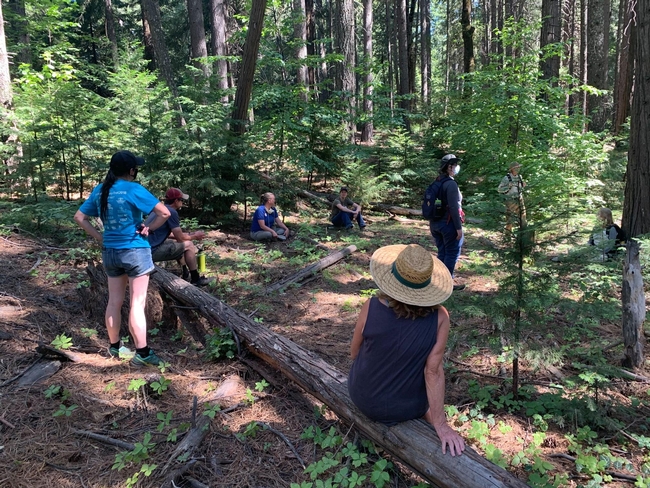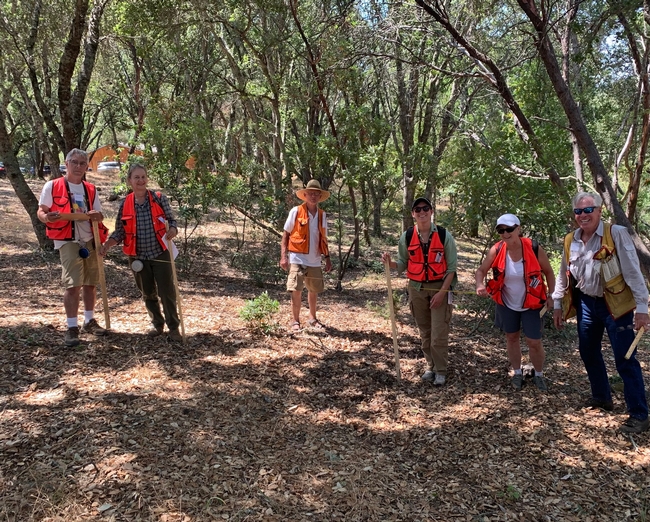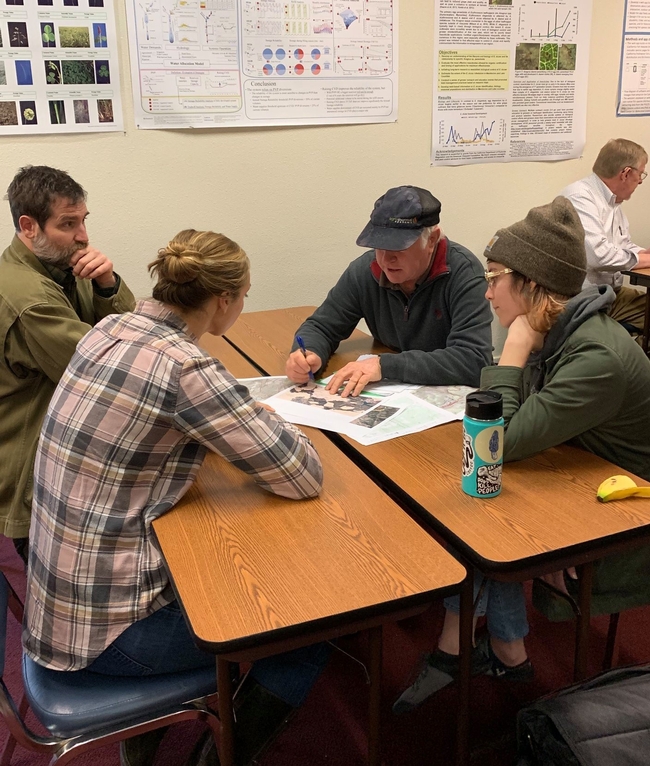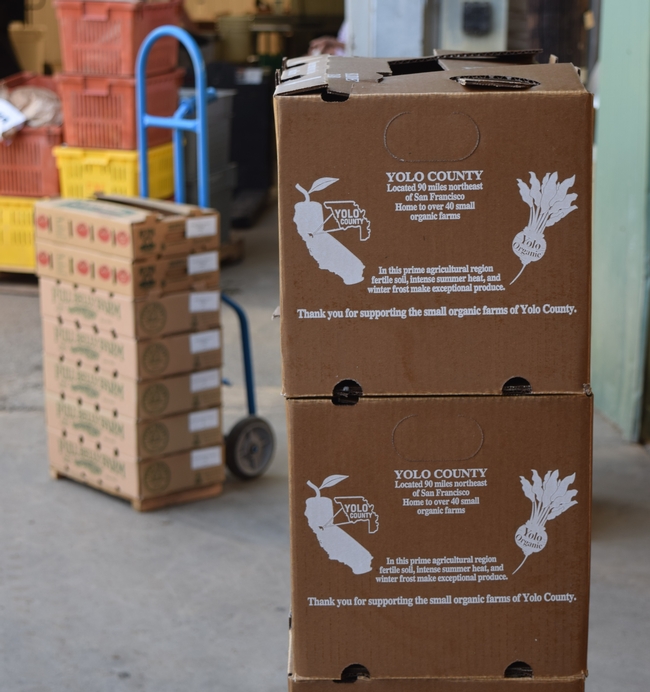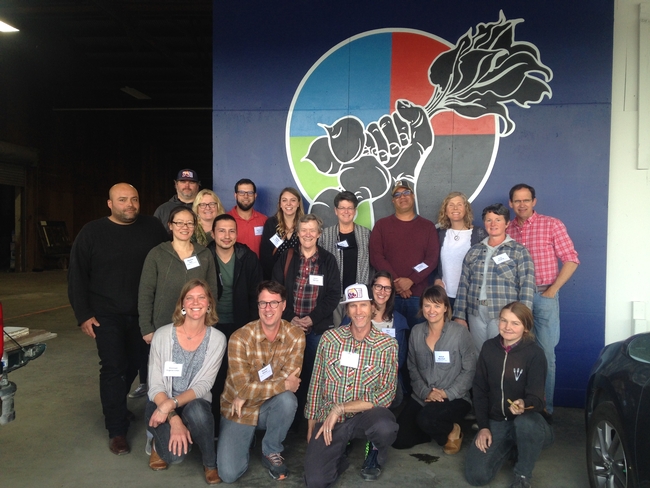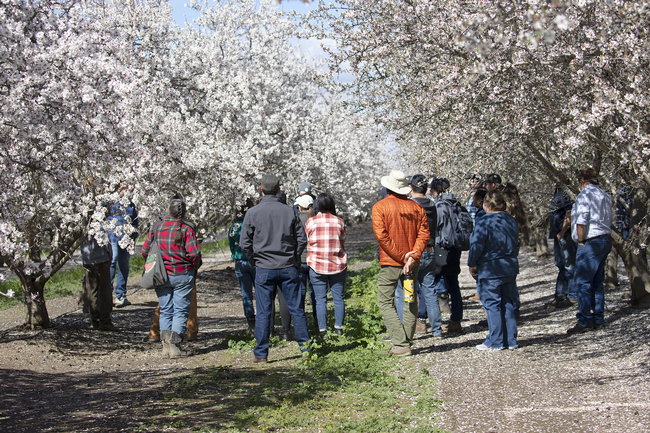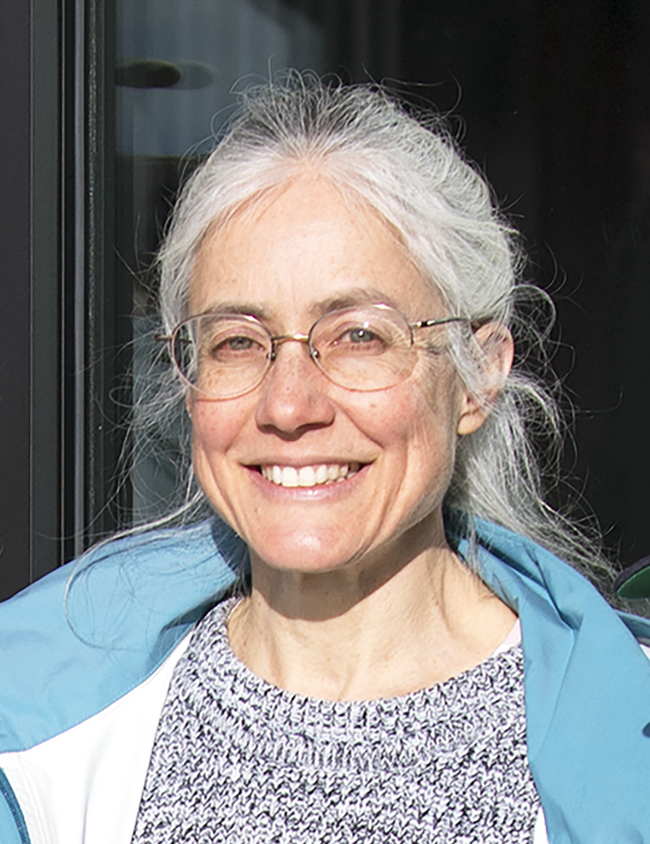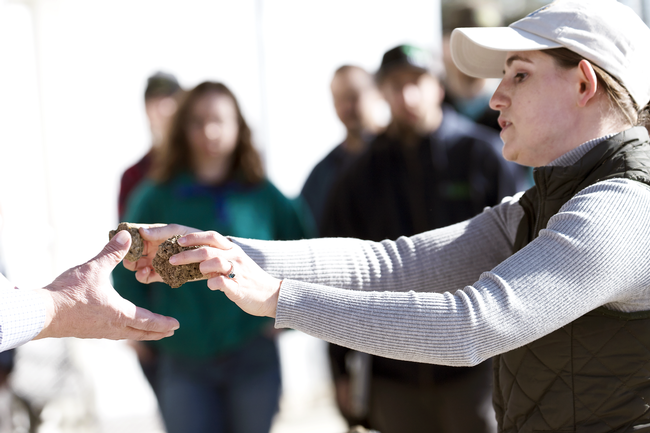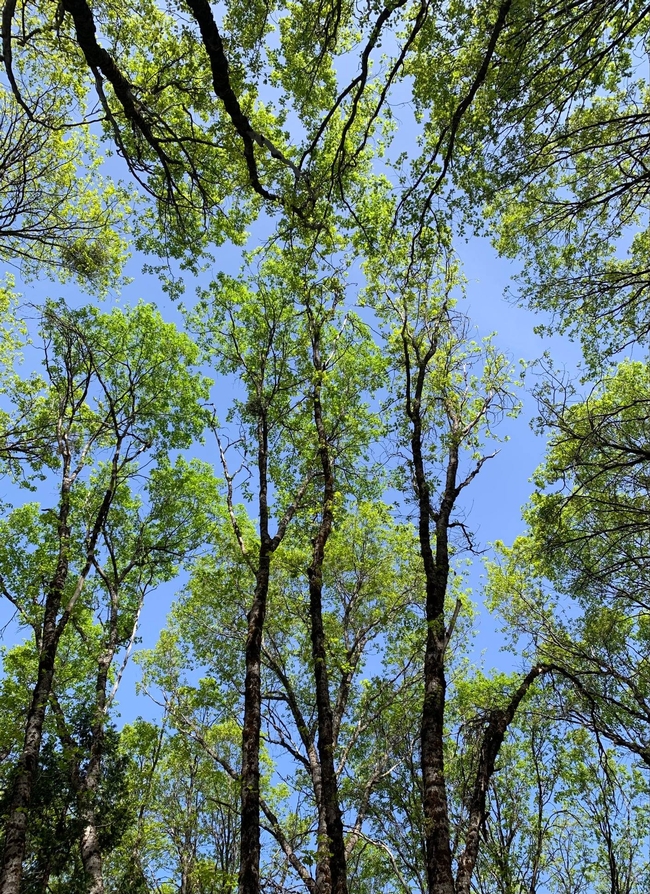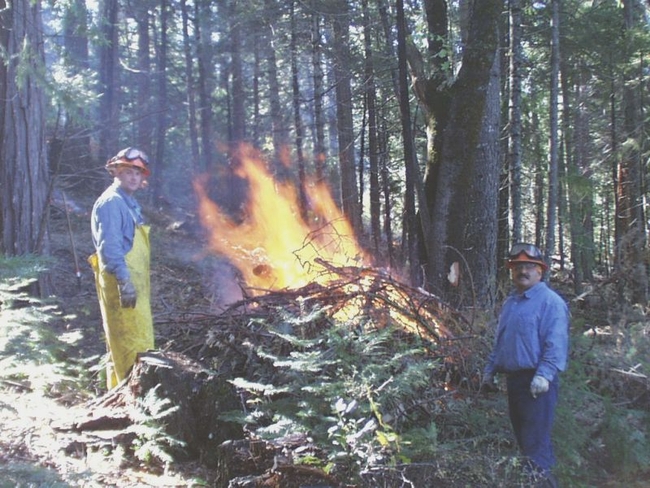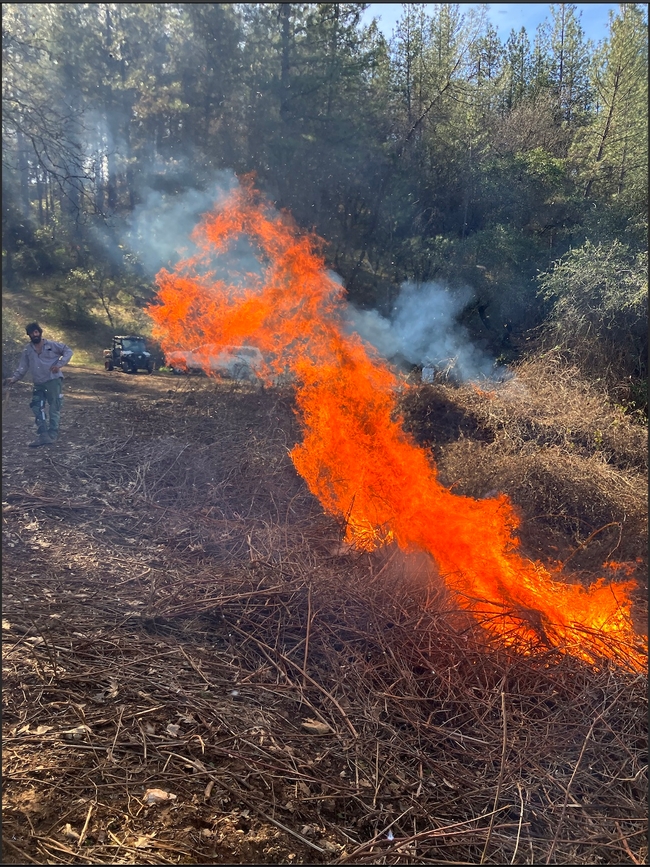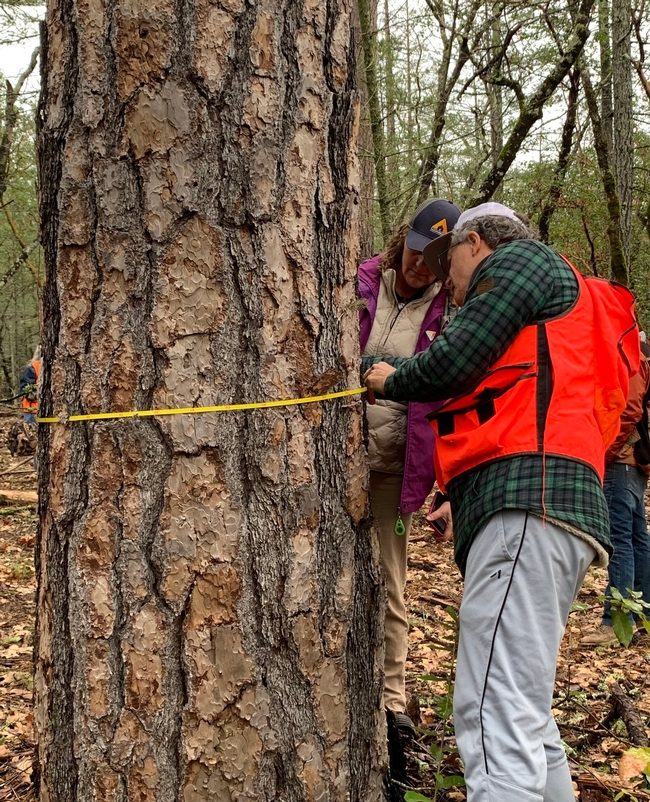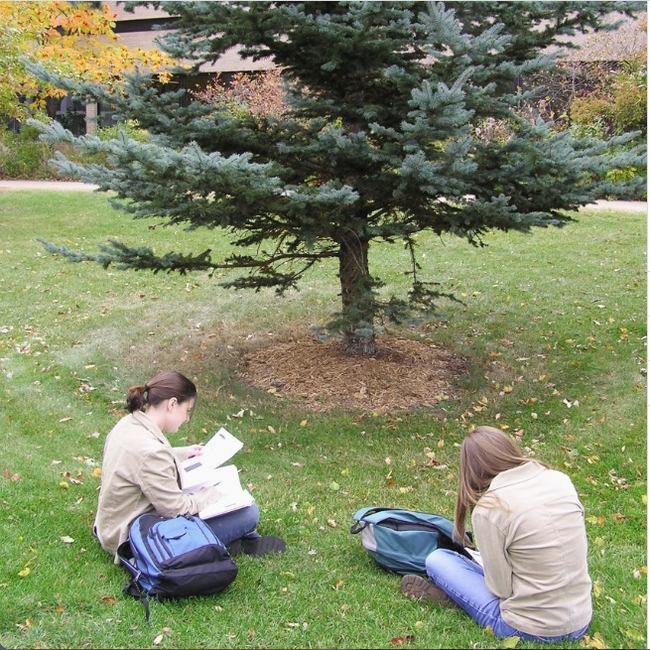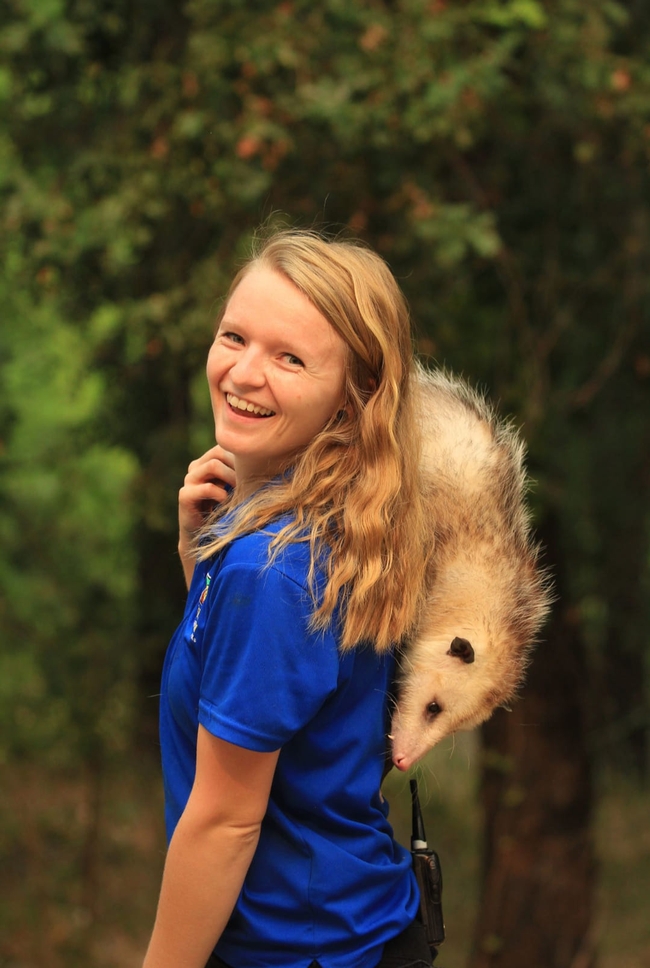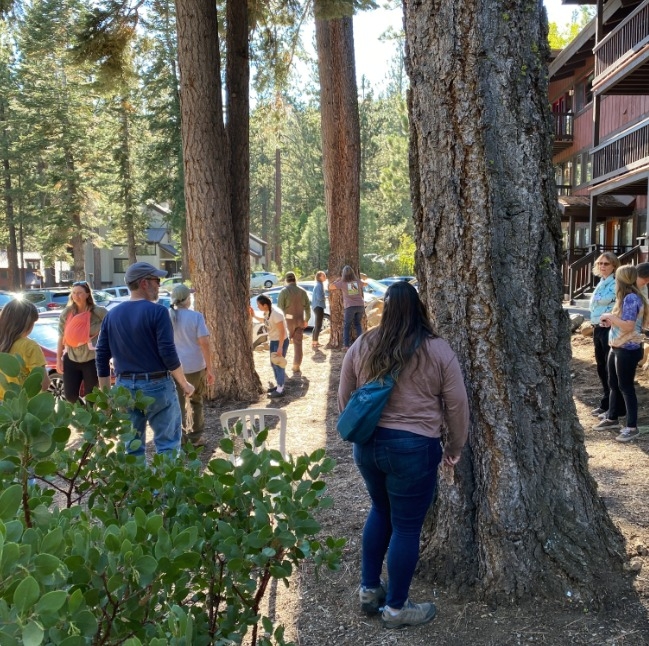Posts Tagged: education
Connecting California’s forest landowners with California Tree School
While trees and forests are often emblematic of constancy in a fast-paced world, our state's forests are actually changing before our eyes. Since 2020, the UC ANR Forest Stewardship Education (FSE) program has been helping California's forest landowners be proactive about the inevitable shifts their forestland will experience. The Forest Stewardship and Post-Fire Forest Resilience workshop programs use an online educational format, which guide landowners through the basics of creating forest management plans and managing post-fire landscapes, respectively. Now, the FSE team is piloting a new program to engage a wider audience of forest landowners and community members passionate about trees.
This spring, the Forest Stewardship and UC ANR Fire Network teams are holding the first California Tree School, where individuals attend multiple in-person classes on the forestry topics they are most curious about. “The existing online programs are very focused on forest management plans and post-fire activity, and [Tree School] lets us tackle other topics,” said UC ANR forest and natural resources advisor Susie Kocher.
A one-stop shop for continuing forestry education
California Tree School was inspired when Forest Stewardship Academic Coordinator Kim Ingram, Post-fire Academic Coordinator Katie Reidy and Kocher attended Oregon State University Extension's Tree School event in Clackamas County, Oregon. OSU Tree School is a day-long experience comprised of classes that cover the different dimensions of forestry: constructing a house from your own timber, carbon cap and trade, and buying portable sawmills are just a small sampling of the options for attendees. OSU Tree School students ranged from forest landowners to community college students, contributing to a space which would facilitate community connections as well as learning.
Kocher described the experience as a “a great one-day, one-stop shop to keep up-to-date on what we [forest landowners and professionals] should know.” Excited by the breadth of opportunities offered at OSU's Tree School, Ingram, Kocher and Reidy were inspired to bring the format to California.
“It's our time to discuss the whole ecosystem,” noted Reidy. “Tree School is bringing in the trustworthy, reliable group of experts who can provide more information on the questions pertaining to landowners' specific goals.”
California Tree School will be offered in two locations this spring, with CA Tree School- Hopland taking place on May 4, and CA Tree School- El Dorado on June 1. Similar to OSU's Tree School, attendees are expected to be a mix of forest landowners, natural resource professionals and interested community members.
Connecting statewide professionals; personalizing forestry education
Tree School offers attendees the opportunity to focus on subjects that pertain to their specific learning needs. This personalized approach is a new foray for the Forest Stewardship team, but is something that Ingram says workshop participants have been wanting for some time.
“Our participants never think they learn enough. They are always asking for more information, and this Tree School gives us the chance to expand on things we might not have had a chance to go over in the workshop series,” remarked Ingram. Additionally, Tree School instructors had creative freedom when it came to developing their classes, from the topic to the class format. This is evident when browsing through each session's class catalog. CA Tree School attendees choose four classes to attend, meaning they can build their first burn pile, understand the ins and outs of regional wildlife, paint outdoors and learn how to aid statewide reforestation efforts all in one day.
“I felt that Tree School created a sense of trust around complex topics,” noted Reidy about her experience last year in Oregon. For CA Tree School, the Forest Stewardship team aims to do the same. This meant recruiting from throughout the UC ANR network and other organizations, including CALFIRE and CARCD (California Association of Resource Conservation Districts), to bring trusted voices to the community.
“What's exciting about Tree School is that we are bringing natural resource professionals from all around to engage everyone at the same time, and all in one place,” noted Ingram.
The team is excited to see all the connections that will be made between community members and professionals during this pilot year, and “if this is successful and we can bring it back next year,” commented Kocher, “we are definitely interested in partnering with more people and expanding our outreach.”
Making CA Tree School an in-person experience was important to the team, as much of the education is hands-on. Additionally, Kocher sees enhanced potential for building personal connections: “In person, you have this opportunity for people to identify as part of a community,” noted Kocher, “So I'm excited for people to hang out with each other.”
Encouraging an informed community
“You can't separate the emotional from the physical, and there are a lot of topics in forestry like wildfire and economics that can be a bit of a downer,” said Ingram. “I'm excited to help create a positive learning environment, and one that encourages folks to turn to UC Cooperative Extension for these resources.”
“Our main goal here is to get science out there,” concurred Reidy. “The more exposure people have to science, the more confident they feel in themselves and their wants and needs.”
Winter season: A time for food safety systems re-evaluation and education for food hubs
The holiday meal season is often a busy time for food hubs – entities that handle the aggregation, distribution and/or marketing of source-identified regional food – as restaurants, retailers and consumers fill their tables and shelves with an abundance of fresh, local products. However, the subsequent winter months can provide a valuable time for reflection and re-evaluation of a food hub's systems and processes. In this spirit, it may be helpful to remind people working at food hubs that University of California Sustainable Agriculture Research and Education Program (UC SAREP) offers a suite of food-safety resources – in English and in Spanish – on its website.
- A step-by-step guide for food hubs on how to pursue a third-party food safety audit with guidance on how to navigate buyers' questions.
- Two sample food-safety plans intended as a starting point to be adapted to a food hub's specific operations and practices.
- Example standard operating procedure, or SOP, documents related to 11 common tasks carried out by food hubs.
“We hope these resources can play a role in helping food hubs to adopt best practices and control risks related to food safety,” says Gwenael Engelskirchen, sustainable food and farming coordinator with UC SAREP, who led the development of these educational tools.
According to the Centers for Disease Control and Prevention, approximately, 1 in 6 Americans (or 48 million people) gets sick and 3,000 die of foodborne diseases annually. In 2011, to help prevent the occurrence of foodborne illness, the federal government enacted the Food Safety Modernization Act (FSMA), designed to outline actions to be taken at various points along the supply chain for both human and animal food.
UC SAREP's Food Safety Resources for Food Hubs are intended to help food hubs navigate these food-safety regulations and accompanying best practices. Resources are also available in Spanish at Recursos de seguridad alimentaria para los centros de distribución de alimentos.
Food safety certification guide
Some buyers verify a supplier's food safety program by requiring an audit performed by a third-party certification body or auditing company. This Guide to Food Safety Certification offers key considerations before deciding to pursue a food safety audit and helps users navigate the food safety certification process.
Food safety plan
Food hubs that meet the criteria for full compliance with FSMA's Preventive Controls for Human Food Rule are required to have a food-safety plan in place. And for all food hubs, having a shared document describing the facility's operations and how potential risks of food contamination are managed is a good idea. Two sample food safety plans, inspired by the operations of food hubs in California, provide a starting point and can be adapted to a hub's own operations.
Standard operating procedures
Standard operating procedures provide detailed step-by-step instructions for how to carry out operational tasks within a food facility. The standard operating procedure samples cover common topics such as handwashing, facility cleaning and more, and are intended to be adapted to a food hub's specific operations and practices.
Jacob Weiss from Spork Food Hub in Davis said, “the templates were a great starting place for us to build the framework of our food safety plan. It helped us figure out what we needed to (and didn't) need to include. I think the SOPs are also really useful because they are broad enough to get you started but flexible enough to add the specific practices of your business or hub.”
For additional information, visit UC SAREP's webpages on Food Safety Resources for Food Hubs or Recursos de seguridad alimentaria para los centros de distribución de alimentos.
These resources and tools were developed in collaboration with various project partners, including Department of Food Science and Technology at UC Davis, Department of Population Health and Reproduction at UC Davis School of Veterinary Medicine, Center for Precision Medicine and Data Science at UC Davis Health, and Community Alliance with Family Farmers.
UC awards Brodt $2M to advance soil health, climate-smart farming practices
Regional farms will demonstrate practices such as cover cropping, reduced tillage, compost and mulch use, hedgerow planting, optimized irrigation systems
To accelerate adoption of climate-smart farming practices, the University of California Office of the President has awarded nearly $2 million to a team of UC Cooperative Extension scientists and community partners working on a network of farm demonstration sites. The project will be led by Sonja Brodt, coordinator for agriculture and environment at the UC Sustainable Agriculture Research & Education Program. This UC Agriculture and Natural Resources project is one of 38 funded with $83.1 million allocated to UC by the State of California for climate action research and innovation.
Scaling up soil health and other climate-smart agricultural practices to sequester carbon, increase water and nutrient use efficiency, and improve the resilience of farms to climate-related threats like drought and floods is a core pillar identified in California's Natural and Working Lands Climate Smart Strategy.
Climate-smart agriculture is a systems-based approach that requires localized adaptation across the diverse soils, cropping systems, socioeconomic and cultural contexts throughout California.
“Our project will strengthen the nascent California Farm Demonstration Network for on-the-ground, regionally specific demonstration of a range of climate-smart practices,” said Brodt. “Regional farms will demonstrate practices such as cover cropping, reduced tillage, compost and mulch use, hedgerow planting, irrigation system optimization and more.”
The $1,999,524 project will pilot a participatory partnership extension model that allows farmers to learn from their peers to reduce adoption risks and adapt knowledge to an ever-changing environment, increasing the likelihood of farmer success and accelerating long-term uptake of complex, place-specific practices.
Building on the capacity of local trusted organizations, project collaborators will be organized in a hub-and-spoke network with three regional Farm Demonstration Hubs (Sacramento Valley, North Coast and Central Coast), a pilot Hmong/Mien Demonstration Hub, and a statewide Organic Demonstration Hub.
Collaborators at each hub will be responsible for identifying and nurturing farm demonstration sites, and conducting demonstration trials and farmer-to-farmer outreach activities. Centralized organization and capacity building will be provided by UC SAREP, UC Organic Agriculture Institute, the California Association of Resource Conservation Districts, the Community Alliance with Family Farmers, and the California Farm Demonstration Network Advisory Panel.
In addition to several UC Cooperative Extension advisors and specialists across the state, partners include the UC Hansen Research and Extension Center and the Rodale Institute California Organic Center, both in Ventura County, and the UC Climate Smart Agriculture Program. Eight Resource Conservation Districts will also be involved in leading Farm Demonstration Hubs.
The project will also conduct soil health assessment activities to inform soil health and resilience monitoring protocols in future research and extension efforts. Since many existing soil health metrics were designed for agroecosystems in the Midwest and Eastern U.S., this project aims to lay the groundwork for research to adapt soil health metrics to the arid and Mediterranean climates of California.
“By utilizing relationships built between demonstration hub managers and demonstration farms across different cropping systems, we will gather quantitative and qualitative soil health data, information about growers' management practices as well as their own perspectives of what they really need to know about their soils in order to better manage for climate resilience and mitigation,” said Brodt.
Ultimately, the project partners aim to establish an enduring on-farm extension and research system that will help thousands of farmers adopt climate-smart practices tailored to their farms.
Other grant-supported projects focus on water access, conservation
The largest of the Climate Action Matching Grants, an $8.2 million investment, supports the development of planning tools to advance sustainable, inclusive and equitable water distribution for California's 39 million people. The project is led by Ted Grantham, a UC Cooperative Extension specialist in the Department of Environmental Science, Policy and Management at UC Berkeley. Kristin Dobbin, UC Cooperative Extension specialist in the Department of Environmental Science, Policy, and Management at UC Berkeley, and Erik Porse, director of the California Institute for Water Resources are collaborating on the project.
Three other projects involving UC ANR researchers received California Climate Action Seed Grants and Matching Grants subawards:
- Development of a hydrogel that can work as a soil amendment to help small-scale vegetable farms conserve water led by UC San Diego associate professor Shengqiang Cai with Ruth Dahlquist-Willard, UC Cooperative Extension small farms advisor and interim director of UC SAREP; Mallika Nocco, UC Cooperative Extension specialist; and Matthew Gilbert, UC Davis professor of whole plant physiology. $297,979
- Development of a tool for predicting climate-water variation led by UC Irvine professor Isabella Velicogna with Tapan Pathak, UC Cooperative Extension specialist. $199,531
- A study of urban stream corridors led by UC Davis professor Gregory Pasternack with Igor Lacan, UC Cooperative Extension environmental horticulture and urban forestry advisor. $33,824
- A study of how California's housing crisis affects the growth of the wildland urban interface (WUI), where the fringes of development reach into natural areas led by UC Santa Cruz professor Miriam Greenberg, with Barb Satink Wolfson, UCCE fire advisor, Devii Rao, UCCE livestock and natural resources advisor, and the Central Coast Prescribed Burn Association.
Updated 8/31/23 to add the wildland urban interface study.
Top 10 tools for new forest landowners
Earth Day 2023 celebrates the ways in which we can all invest in our planet, and forest landowners play a considerable role in this. Part of being a forest landowner is deciding where and when to invest your time, money and energy. To assist them, the UC Cooperative Extension Forest Research and Outreach team collaborated with four experienced landowners to highlight 10 tools a first-time forest landowner can invest in.
Listed below, these 10 tools expand past saws and rakes to include tools that educate landowners and support their management activities. We hope this compilation gives readers new to forest management a proper start.
1. Management Goals: Every tool a new forest landowner buys should help advance a management goal. Each of the four interviewees emphasized that understanding what you and your land need is the number-one priority to be investing time and effort into.
“That's my management goal: a healthy forest with as much biology as I can support. Keeping the big trees, letting fire in every once in a while…and correcting the problems we've caused in the past. The species we have here now, it's mostly white fir. People took out the Douglas Fir, the Sugar Pine and you have to do enough thinning to replant those species because they're not coming in that fast underneath the dense fir forest.”
-Brent, Nevada County
2. Pruning and Cross-cut saws: When completing thinning or clearing projects, every forest landowner has their go-to saws. Cross-cut saws are used for cutting down trees, whereas pruning saws cut away dead or diseased branches. Don't forget to look outside of the box for your tools, as one landowner told us about her preference for Japanese tools.
“My Japanese pruning saw… it cuts like butter! It can easily take down trees up to four inches in diameter. The Japanese-made tools, they're smoother and sharper.”
-Danica, Sonoma County
3. A McLeod was cited by each of the four landowners as a must-have tool in every forest landowner's tool kit. One side can be used as a hoe and the other side as a rake, making it useful for activities ranging from trail building to raking in brush for a pile burn.
“For pitching stuff in and raking things out [of a pile burn], you're going to need a McLeod. And if you want to clear a brush pile, it's heavy. And it [the McLeod] works really well for that.”
-Brent, Nevada County
4. Succession or legacy plan: Thinking about who will take care of your land after you is a key aspect of successful forest management. However, bequeathing land to a family member isn't the only option. You could also consider donating your land to a local tribe or to group like the Nature Conservancy.
“[Regarding legacy] On the forest that we manage, we have a conservation easement so it can't be developed. But it doesn't stop it from being logged…How do you conserve? How do you decide? You can let an organization manage it, but it might be in their interest to thin [the forest]. I'll do what I can - I'll set it up for you [the next generation] and hope that there's a shift in the future and we'll learn to steward our resources.”
-Brent, Nevada County
5. Weed Wrench: What to do when you encounter an unwanted plant? When restoring native plants and clearing unwanted invasives, some species are more difficult to uproot than others. If your garden shears aren't cutting it, reach for a weed wrench like the one here.
“I have a lot of bay laurel and there's a lot of saplings that come up and they resprout vigorously. You have to literally pull it out by the root…so I use a weed wrench, and that's been a really valuable tool for me. It's also good for Scotch Broom, anything that has a small diameter neck that you can clamp on to and leverage out.”
-Sacha, Humboldt County
6. Newsletters: Sometimes reading about what other landowners are doing can help you find inspiration for management activities. The Forestland Steward newsletter, which covers general forest management news and events, would be a good place for a new landowner to begin. Additionally, subscribing to newsletters that cater to your region and management goals is a simple way to find applicable management recommendations.
“I subscribe to a bunch of email newsletters, and those are constantly talking about…like, what upcoming events are going on? What are educational conferences going on? I'm constantly getting research articles, casual writings, webinars…For me, I'm personally interested in good fire, so I subscribe to a lot of resources that are focused on using fire as a land management tool.”
-Sacha, Humboldt County
7. Record keeping: Come tax season, you will thank yourself for investing time in keeping records of your management activities. If you find yourself receiving funding in the form of grants, conservation easements or other programs, having a trusted tax advisor or accountant should be a consideration. A close collaborator with the Forest Stewardship Program, Larry Camp, (Registered Professional Forester, forest landowner and retired IRS agent) notes, “Treating your forestland as a business or investment is an important step forward in efficiently managing your forest and can lead to incentives and deductions that will legally reduce your tax burden.”
8. Land History: For many forest landowners, learning about indigenous history is not only fascinating, but a thoughtful reminder of the original caretakers of California forestland. Investigate your land and delve into Traditional Ecological Knowledge (TEK), which may inspire new projects.
“When we're talking about land and access to land, I think it's always good to be thinking about tribal sovereignty, and what are actions we can do to support that. Historically, this [land] was an oak woodland…we're playing catch up over 150 years of fire suppression policies. I'm working towards oak woodland restoration, and part of that is that tie-in to responsibility to tribal access.”
-Sacha, Humboldt County
9. Management education resources: Though we at UCCE have our own Forest Stewardship Workshop series, there are often informational webinars and videos offered through regional organizations. The California Wildfire and Forest Resilience Task Force website has a list of educational resources for landowners, found here.
“I'm big on education, and when you're participating in that educational group, they [program participants] might throw out a different name, or a different agency you can use. It's really about being involved and taking up the suggestions that people give you.”
-Laura, Nevada County
10. Community: Getting connected with organizations like your local Resource Conservation District (RCD), Natural Resources Conservation Service (NRCS), CAL FIRE, or UC Cooperative Extension (UCCE) office can be a big help to new landowners. These organizations house experts such as Registered Professional Foresters (RPFs) who can provide technical assistance and assist in applying for permits or drafting a management plan. Devote time looking into region-specific organizations such as the Foothill Conservancy and My Sierra Woods that service multiple counties. Peer networks are a plus as well. Community ties were continuously cited by the forest landowners we spoke to as being a valuable resource.
“Try to figure out what organizations are around you that are doing stuff. Around here, there's the Mid-Klamath Watershed Council, and they'll have invasive plant removal days, and you can go and volunteer. Doing something like that, where you're hands-on and connecting with other people is what I'd suggest.”
-Sacha, Humboldt County
“My community…is definitely close knit, because it's tough! It's a lot of work. And, you know, if I'm renting a chipper and it's up at my property and someone else wants to use it, they can. It's very, very helpful to be close with your neighbors and learn from them.”
-Laura, Nevada County
Project Learning Tree: Shaping the future of California forests
On this International Day of Forests, we at UC Cooperative Extension Forest Research and Outreach invite you to celebrate the future of California's trees with us. Considering the recent news coverage regarding tree mortality in California, we want to instead view this subject through a lens of hope. For it's not just the news outlets witnessing the extent of forest die-off: children, especially those in forested communities, are seeing the effects of drought, wildfire, and fire suppression policies in real time.
Project Learning Tree is a national education program leading the next generation to witness and then act on these changes. Children are the future of our forests, and we think the efforts of Project Learning Tree are a cause for celebration, don't you?
Last month, Californians may have noticed a marked uptick in the news coverage of the state's forests. Local, state and national news outlets all reported on the startling approximation of 36 million trees that perished between 2021 and 2022. This number, gleaned from USDA Forest Service data, is a startling jump from the 9.5 million trees that perished the year before. The future of California's forests does not have to look like this, with large fluctuations and ever-rising numbers of dying trees. Right now, it's not easy being a tree. In 10 or 20 years? We're hopeful that the situation is different.
Project Learning Tree (PLT), stretches across the nation to connect students to forests, even if they live miles away from one. Jonelle Mason, the PLT coordinator for Northern California region, provided more insight into the program's purpose through a sentiment many may be familiar with: “To quote Jane Goodall, ‘Only if we understand, will we care. Only if we care, we will help.'” Project Learning Tree is one piece in the future of forest stewardship, and as Jonelle sees it, “Forming forest-education generations creates passionate advocates. People can't save what they don't know about.”
A point touched on by nearly all news outlets covering tree mortality was the centuries of fire suppression practices and its ripple effects that amplify drought and wildfire damage. Students in California are aware of natural disasters affecting forests and forested communities, but not necessarily the causes.Mason posits that in closing that knowledge gap, PLT can “cultivate environmental defenders [who] will ultimately push us in the right direction.”
A crucial aspect of Project Learning Tree is that it exists as a continuing education program, meant to follow students from kindergarten to senior year of high school. Each year of learning builds upon the last, yet the topics are given nuance and depth even at the elementary school level. For instance, PLT's flagship K-8 curriculum gives second grade teachers the tools to communicate ecosystem services, plant structure and natural resource cultivation. High school teachers following the “Focus on Forests” education guide will find avenues to introduce concepts like environmental policy, and will help students understand the difficult decisions that many forest landowners face.
It does indeed give us a reason to celebrate the future. Young people are more active in the conversations surrounding the environment and climate change, and are aware that something must be done to protect the natural resources they have left. It's vital to translate that passion and interest into true learning, where a classroom can become the space for developing ideas for what can be done about our state's forests. Mason is quick to point out the core tenant of PLT that makes it unique: “Teaching students how to think, not what to think, about environmental concerns.”
Project Learning Tree presents concepts to students and gives them the tools to think critically through the many fields that touch forests, from the natural sciences to philosophy. California's youth has a vested interest in protecting and managing their forests, and programs like PLT give us hope that the interest can truly be translated to action.
If you are interested in bringing Project Learning Tree to your school or home, you can contact Mason at jmason@ucanr.edu.

